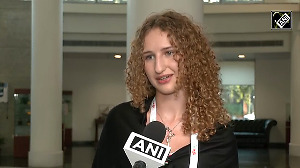"Whatever we may not know about the future course of H5N1, we do know this, once human-to-human transmission has been established, we would have only a matter of weeks to lock down the spread before it spins out of control. That is why the international community must take action now," Annan said addressing experts who are meeting in New York to consider the threat of bird flu to humans.
Stressing that merely stockpiling antiviral medicines does not constitute a strategy, Annan said, currently, it is not known whether the present strain of avian flu will cause a human pandemic. "But we do know what a human pandemic is," Annan told the Time Global Health Summit, a three-day event in New York to discuss key health issues.
"We do know what happens when millions of people die, and millions more are infected, when health systems are overburdened and overwhelmed, when families, communities and whole societies are devastated, when transport and trade, education and other services are disrupted or cease to function, When the economic and social progress of nations risks being reversed," he said.
Experts in New York have called for a series of measures from health to economic, including stockpiling vaccines, shoring up economies of affected nations and quickly isolating affected areas, should the deadly avian virus mutate.
They also suggested establishing an international fund to help the poor nations take preventive measures and to provide compensation to producers for culled poultry. The compensation was particularly important to ensure that the producers report the cases of bird flu.
"A threat like a flu pandemic cannot be addressed by one organisation, one group of countries, one sector or one profession," Annan said. "It presents us with an extraordinary collective challenge and it calls for an extraordinary collective effort".
H5N1, the deadly virus, first infected poultry and has now been found in birds in Europe. And experts say if the experience of previous outbreaks which killed millions is any guide, the next episode could be much more deadly in the days of globalisation and fast travel.
At their meeting on Thursday, experts called for greater investments in veterinary infrastructure to halt spread of virus among the birds, changing habits of people living in close proximity with animals to ensure minimal contact, fostering transparency and cooperation in research, scaling up production of antiviral drugs and communicating vital facts about the virus.
"Silence is death," they said.
Apart from measures at the operation level, they stressed on the need to mobilise world leaders at the political level and identifying measures that would be required to keep the affected countries running.
A senior UN health expert admitted that no one can predict the risk of a possible mutation of the virus into a pandemic, nor its potential death toll, which some estimates have put in millions.
"This virus can become more virulent as it mutates, more strong, it can become less virulent. It can pick up human transmissibility or it can't pick up human transmissibility," UN World Health Organisation expert David Heymann said.
"The risk is there, it's a true risk, but it can't be quantified," he said.
"The UN system needs to re-task itself," to aid prevention against a pandemic and support the needs of developing countries," the Senior UN System Coordinator for Avian and Human Influenza David Nabarro said.
Speaking for the UN Food and Agricultural Organization, Assistant Director-General Louise Fresco said the cost of prevention at source among animals would be about 425 million dollars, but only 30 million dollars have been made available so far.
"Now that 425 million dollars, we know from experience, is peanuts usually compared to the costs which you will have when you have to eliminate entire poultry sectors," she said at a news conference.
Ever since the first human case of bird flu, linked to widespread poultry outbreaks in Vietnam and Thailand, was reported in January 2004, health officials have warned that H5N1 could evolve into a global influenza pandemic if it mutates into a form which could transmit easily between people. The so-called Spanish flu pandemic of 1918-1920 is estimated to have killed from 20 million to 40 million people worldwide.
In the present outbreak there have so far been more than 121 reported human cases, 62 of them fatal, all in South-East Asia. But no human-to-human transmission has been reported so far. Some 140 million domestic birds have died or been culled in an effort to curb the spread.






 © 2025
© 2025